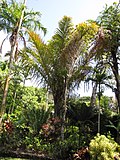- Raffia can be used in tree grafting.
- Kuba raffia cloth panel
- Kongo raffia cloth mpu (hat)
- Raffia is woven to make the traditional Munganji dancer suit used in Bapende ceremonies in the Gungu region of Bandundu Province, Democratic Republic of the Congo.
- Raphia animals in Madagascar
| Raffia palm | |
|---|---|
 | |
| Scientific classification | |
| Kingdom: | Plantae |
| Clade: | Tracheophytes |
| Clade: | Angiosperms |
| Clade: | Monocots |
| Clade: | Commelinids |
| Order: | Arecales |
| Family: | Arecaceae |
| Subfamily: | Calamoideae |
| Tribe: | Lepidocaryeae |
| Genus: | Raphia P.Beauv. |
Raffia palms are members of the genus Raphia. The Malagasy name rafia is derived from fia "to squeeze juice". [1] The genus contains about twenty species of palms native to tropical regions of Africa, and especially Madagascar, with one species ( R. taedigera ) also occurring in Central and South America. [2] R. taedigera is the source of raffia fibers, which are the veins of the leaves, and this species produces a fruit called "brazilia pods", "uxi nuts" or "uxi pods". [3]
Contents
- Cultivation and uses
- Fiber
- Raffia wine
- Other uses
- Synthetic raffia
- Species
- References
- External links
They grow up to 16 metres (52 ft) tall and are remarkable for their compound pinnate leaves, the longest in the plant kingdom; leaves of R. regalis up to 25 metres (82 ft) long [4] and 3 metres (9.8 ft) wide are known. The plants are monocarpic, meaning that they flower once and then die after the seeds are mature. Some species have individual stems which die after fruiting, but have a root system which remains alive and sends up new stems which fruit. The Raphia palms are remarkable in being one of just two genera of flowering plants having the very rare phyllotaxy of 1/4 (the other is Laccosperma). [5] Perhaps even more remarkable is the "King Raphia" (Raphia vinifera variety nigerica) which is the only known palm with pairs of opposite fronds. [6]














